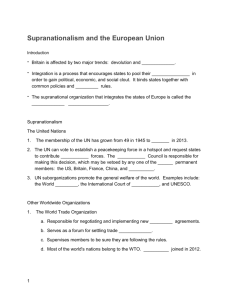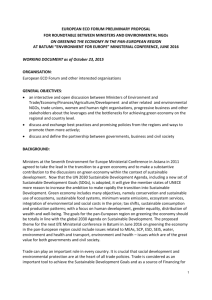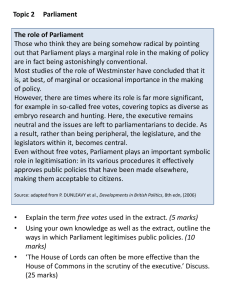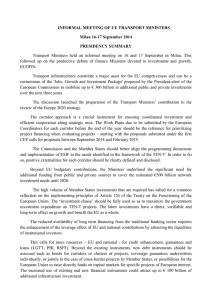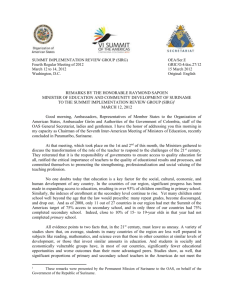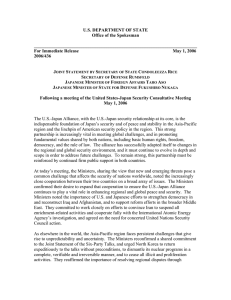Criteria for Assessing Housing Policy Options
advertisement
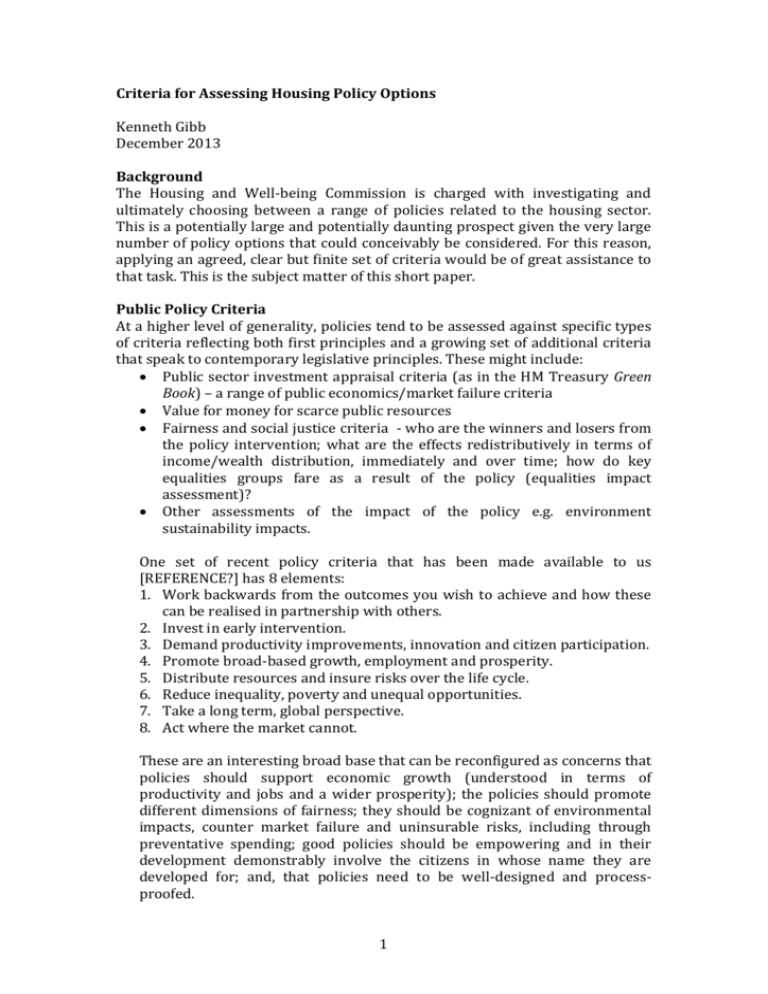
Criteria for Assessing Housing Policy Options Kenneth Gibb December 2013 Background The Housing and Well-being Commission is charged with investigating and ultimately choosing between a range of policies related to the housing sector. This is a potentially large and potentially daunting prospect given the very large number of policy options that could conceivably be considered. For this reason, applying an agreed, clear but finite set of criteria would be of great assistance to that task. This is the subject matter of this short paper. Public Policy Criteria At a higher level of generality, policies tend to be assessed against specific types of criteria reflecting both first principles and a growing set of additional criteria that speak to contemporary legislative principles. These might include: Public sector investment appraisal criteria (as in the HM Treasury Green Book) – a range of public economics/market failure criteria Value for money for scarce public resources Fairness and social justice criteria - who are the winners and losers from the policy intervention; what are the effects redistributively in terms of income/wealth distribution, immediately and over time; how do key equalities groups fare as a result of the policy (equalities impact assessment)? Other assessments of the impact of the policy e.g. environment sustainability impacts. One set of recent policy criteria that has been made available to us [REFERENCE?] has 8 elements: 1. Work backwards from the outcomes you wish to achieve and how these can be realised in partnership with others. 2. Invest in early intervention. 3. Demand productivity improvements, innovation and citizen participation. 4. Promote broad-based growth, employment and prosperity. 5. Distribute resources and insure risks over the life cycle. 6. Reduce inequality, poverty and unequal opportunities. 7. Take a long term, global perspective. 8. Act where the market cannot. These are an interesting broad base that can be reconfigured as concerns that policies should support economic growth (understood in terms of productivity and jobs and a wider prosperity); the policies should promote different dimensions of fairness; they should be cognizant of environmental impacts, counter market failure and uninsurable risks, including through preventative spending; good policies should be empowering and in their development demonstrably involve the citizens in whose name they are developed for; and, that policies need to be well-designed and processproofed. 1 A recent book by Anthony King and Ivor Crewe (The Blunders of our Governments) also identifies common factors going back to the Thatcher governments, suggest a number of personal and institutional causes of policy failure. These are worth dwelling on when we think of policy criteria (they are in a sense, their mirror). The illustrations of human error are: Cultural disconnect – ministers and advisors making assumptions that we are the same as them.. Groupthink – the pressure to conform requires an institutional counterbalance, a devil’s advocate to stop uncritical and unthinking consensus. Prejudice (and not enough pragmatism). This is about intellectual prejudice and making unwarranted. Operational disconnect – the authors feel however that too many ministers are not interested in operations. Panics, symbols and spin – the prioritisation of spin leads to panic and kneejerk policymaking, often led by populist but un-analytical media. Systemic failures: The centre can’t hold – compared with other successful and otherwise relatively effective nations, the UK prime minister’s office is tiny and cannot cover the range of government – so it cannot adequately control or direct its ministries. Musical chairs – There is simply too much ministerial movement compared with other countries where ministerial tenure is long enough to get genuine expertise and commitment into the job. Ministers as activists – and as a consequence of the above, ministers want to make an impact, be very active and memorable so that they can advance their career. Lack of accountability – it is often argued that compounding these problems are systemic accountability failures in terms of individual ministers. A peripheral Parliament - the authors fret about the lack of Parliamentary control and influence, the weakness of what used to be called standing committees on legislation and, slightly surprisingly, laud the Scottish system that both combines select and standing scrutiny functions (and can also initiate legislation). Asymmetries of expertise – this is the well-known principal-agent problem with ministers and advisors over-relying on consultants – the authors argue that blunders in government have on occasion followed from excessive reliance on experts from outside. A deficit of deliberation. – the absence of evidence and the failure to draw sufficiently from, carry out and indeed learn from pilots. Housing Dimensions The multi dimensional nature of housing needs to be factored into the development of criteria. Housing is often termed the ‘wobbly pillar’ of the welfare state: both of the market and non-market. Not only is housing an important market sector but it has pervasive intervention both in that market sector and also in the non-market, social housing parts of the system. Tenure matters also because housing is both a consumption activity and an 2 investment/asset – and a well-functioning housing market balances affordable rents and mortgages with sufficient rates of return for investors. This may also suggest that concepts such as the social rate of return might be useful as criteria. Intervention is pervasive and we must question how effective and appropriate the intervention actually is: regulation, tax/subsidy, provision and housing-linked income transfers. And, of course, there are important interventions in related sectors: the land market, finance and housing development. Policy criteria thus is not just about diagnosing the need for an intervention but also assessing the kind of intervention proposed and the implementability of the policy options. Housing lasts a long time and the housing stock only changes very slowly. Even with a much more efficient housing supply delivery system responding more quickly to demand, it will remain a system dominated by the existing housing stock. This means that policy aimed at significantly changing the housing system will take time. Policies such as those that would aim to for instance make a major change to housing supply will need several years to work up and implement. This means, as with the 2003 homelessness legislation, that there must be a strong degree of political and public consensus that can be sustained over more than one Parliamentary term and a change of government. In a recent study I was involved in for the Joseph Rowntree Foundation (an evidence review of national and international innovations in financing affordable housing supply), we identified a number of criteria with which to assess the large number of policies we uncovered. We identified the following: Simplicity and transparency of model (e.g. can stakeholders understand and apply the model e.g. if it is a policy transfer from another economy; does it overcome critical hurdles such as EU State Aid policy?) Who does it house? Is the policy targeted at the poorest, those on moderate incomes, or specific life cycle stages (e.g. young households without assets) and how is the policy measured or defined? Value for money for the taxpayer and implied subsidy levels and distribution of risk. Robustness and sustainability (i.e. long term stability, relative insulation from risks and capacity to ride out economic and other ‘shocks’ over the long run periods required for housing funding). Volume and the potential of policies to achieve scale. Efficiency (concerned with dimensions of relative low cost, low waste, the avoidance of “dead weight”, targeted to objectives and minimization of unintended consequences, e.g. crowding out, or pushing prices up). Effectiveness – practical performance reaching target groups and alleviating housing-related problems. These are I think useful criteria – particularly the notions of ‘volume’ – that the policies can make an impact at scale (and do so relatively quickly), and 3 also the idea that the policies should be less susceptible to economic shocks and can robustly ride them out. We concluded the research by arguing that, despite the need to move to scale quickly, policy development needs to be piloted carefully to reduce unintended consequences i.e. the criteria may not all be mutually consistent at a point in time. We also concluded that there were strong grounds for what we called ‘rule consistency’, drawing on a term from macroeconomic policy. The idea is simply that once a vision and series of policies are formulated, all successive policies should be completely consistent and complementary to the policy framework in place – it is remarkable how often they are not (e.g. help to buy). Conclusion: Possible Criteria to Take Forward From the general public policy and more specific housing discussions, what conclusions might we reach in terms of criteria to use for the Commission in evaluating alternative housing policies? 1. Fit with general goals of the policy programme (vision) 2. Consistent with complementary objectives associated with economic prosperity, fairness and environmental sustainability 3. That the policy offers good value for money for scarce public resources 4. The policy makes an appropriate intervention to tackle identified or diagnosed market failures 5. That policy transactions costs and processes for its effective implementation are developed as efficiently as possible and with wide and deep citizen/partner involvement in the development of the policy as practical. 6. Policy design and implementation are assessed to test for policy failure according to human error and systemic failures. 7. Housing specific policies should also be consistent with the criteria above concerning efficiency, effectiveness, targeting, volume and robustness. 8. We may also want to consider preventative spending housing policies and take a wider social rate of return approach to accounting for policy effectiveness. This paper is for discussion, amendment and development. 4
